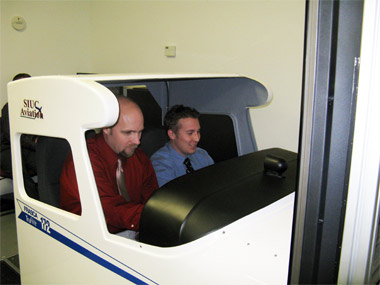
Learning to fly -- Southern Illinois University Carbondale flight instructors Mike Robertson, left, and Garrett R. Gieker, train on the Department of Aviation Flight’s new Frasca TruFlite 172 glass cockpit simulator at Southern Illinois Airport. Aviation flight students will receive training in the simulator starting this semester. The simulator features a Garmin G-1000 avionics package. Robertson is an assistant professor and assistant chief flight instructor and safety officer. The simulator arrived in mid-December. (Photo by Pete Rosenbery) Download Photo Here
January 14, 2009
New simulator enhances aviation training
CARBONDALE, Ill. -- It’s a clear morning with bright blue skies, but the scene inside Southern Illinois University Carbondale’s newest aviation flight simulator reveals a much different setting.
A snowy runway with limited visibility -- or a myriad of other real-world scenarios -- await aviation flight students who will work to maneuver a Cessna 172 safely to the ground.
SIUC’s Department of Aviation Flight received its Frasca TruFlite 172 simulator in December. Aviation flight instructors spent last week involved with in-service training with the simulator, which features a Garmin G-1000 avionics package.
The simulator, which aviation flight students started to work in this week to start the spring 2009 semester, enhances the aviation flight program’s instrument training curriculum, said John K. Voges, an assistant professor, chief flight instructor, and program coordinator in SIUC’s Department of Aviation Management and Flight.
“You get a very realistic view of what you will see outside the airplane if you were actually flying it,” Voges said.
The aviation management, aviation flight and aviation technologies programs are signature programs at SIUC, and a part of the College of Applied Sciences and Arts.
The department’s other five flight simulators remain valid training tools, but “still utilize instrumentation that remained unchanged for many decades,” Voges said.
“The new technology reflects state-of-the-art avionics glass cockpit technology, and incorporates GPS weather and traffic information integrated directly into the cockpit,” he said.
The added visual perspective -- which can include adverse weather conditions, different cloud layers and thunderstorms -- gives students more information and another element in their decision-making process. The simulator also gives instructors the chance to replicate real-world scenarios without the fuel costs.
A large flat-screen visual display mimics what pilots see outside the airplane.
“Now the students will be able to execute an instrument approach, arrive at their minimum altitude and look out and see if they can actually see the runway and see the approach lights. If not, then they make their decision,” Voges said. “If they do see them, then they will continue to land on the synthetic runway. These are all things our instructors are going to be able to control. It gives an extra level of realism.”
There are two LCD flat-screen monitors inside the cockpit that provide pilots with a bevy of information in a much more user-friendly setting, Voges said. The avionics inside the cockpit, which includes GPS technology, is the same Garmin-manufactured equipment found in actual airplanes.
“We role-play while we are here but we are then able to take that degree of role playing to reality in a much greater level,” he said.
Instructors set up the different scenarios. The flight simulator also offers the ability to digitally record a student’s flight so instructors and students can review their work and make improvements where needed, Voges said.
The scenarios can also include in-flight system failures to gauge how students go through trouble-shooting processes to resolve the issues while continuing the flight. The package also features dynamic control loading -- simulating the pressure and pull on the controls as the plane accelerates down the runway and takes off.
“With sophisticated avionics packages, the ability to troubleshoot and process the situation, how to resolve it and continue their flight is critically important component,” he said. “That is really a big issue in our industry today. Many of the newer manufactured aircraft and the aircraft our students are ultimately going to fly on have this type of technology.”
The advanced avionics package includes an integrated autopilot system. Just as flying an airplane mechanically, hands-on, is a skill, flying one with an autopilot is another acquired skill, and provides students another level of experience, Voges said.
The newest simulator is a first step, said professor and department chair David A. NewMyer. His goal is to obtain one or two more of these simulators, along with some aircraft with glass cockpit technology. A state grant for more than $50,000 helped defray the $200,000 simulator price tag. Aviation flight student fees paid the remaining amount, NewMyer said.
But gaining the technology is notably important for the nationally recognized program, Voges said. The Aviation Accrediting Board International is reviewing the department’s request to have its flight training program accredited “and one of the key things they were pleased to see we are incorporating into our training regimen is glass cockpit technology,” Voges said.
“Glass cockpit technology is here and more and more airplanes are coming online,” Voges said. “To have this technology to transfer to the aircraft is essential for a flight training program of our size.”
